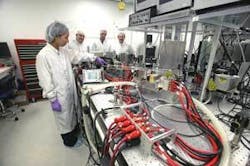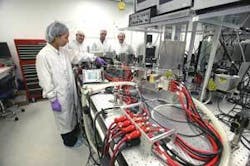Northrop Grumman solid-state laser intended for several kinds of military missions
REDONDO BEACH, Calif. - Scientists at the Northrop Grumman Space Technology segment in Redondo Beach, Calif., are developing a high-energy, solid-state laser called Vesta that company officials claim is powerful enough to perform many basic military missions.
The company-funded laser weapon is expected to speed the time necessary for lasers to go from the laboratory onto the battlefield
The Vesta laser weapon features high power, tight beam focusing, and long run time packaged in a compact laser device that represents significant reductions in size and in the weight of the laser from previous systems, Northrop Grumman officials say.
Beam quality refers to how well the beam can be focused, ultimately defining how much of the beam can project onto a target. Good beam quality and high power could enable Vesta to place high levels of power onto a targeted spot.
“With such superb beam quality, Vesta can be effective at a lower power level than what would otherwise be required for many major military missions,” says Alexis Livanos, president of Northrop Grumman Space Technology. “This new advancement in solid-state laser technology will serve as the building block for many future military systems.”
Potential uses include protecting important military installations, soldiers, ships, and aircraft, as well as precision strike by manned and unmanned aircraft.
Detailing the technical advancements that have been built into Vesta, the company says the new laser weapon has demonstrated brightness of less than 1.3 times the theoretical diffraction limit. By comparison, a typical industrial laser for welding would have a beam quality exceeding 20.
Weapon-system applications typically seek beam qualities of 1.5 to 2. Beam qualities less than 1.5 for high-power lasers are considered outstanding, company officials say.
The laser operates at a power of 15 kilowatts continuous run time, and can operate at this power and beam quality level indefinitely-even demonstrating more than 20 minutes of continuous operation with no degradation.
“For lasers to have military utility, they must not only have the required power, but they must also have excellent beam quality to allow the beam to be focused on targets at a distance,” says Mike McVey, president of the Northrop Grumman Directed Energy Systems business area. “To achieve this milestone, substantial progress was made in the key element of the laser-the gain module.”
McVey notes that Vesta’s key building block, known as a gain module, is easily assembled and has reproducible performance of greater than 4 kilowatts. The Vesta laser uses these gain modules to produce 15 kilowatts. The combination of gain modules forms what the company calls amplifier chains, which are in turn building blocks for higher-power lasers.
Vesta can help reduce risk for the company’s work under the Joint High Power Solid State Laser (JHPSSL) Phase 3 program, which is funded by the Army, High Energy Laser Joint Technology Office, Air Force, and Navy, McVey says.
JHPSSL 3 has a goal of developing a solid-state laser system to reach the 100 kilowatts power level and will use eight of these amplifier chains. The chain construct also facilitates providing various power levels for different applications, and high reliability through a graceful degradation design.
For more information contact Northrop Grumman Space Technology online at www.st.northropgrumman.com.

